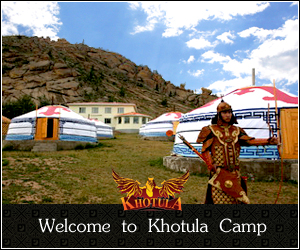Mongol Empire
In 1206, the year of the Tiger, Temujin managed to unite the Merkits, Naimans, Mongols, Uighurs, Keraits, Tatars and disparate other smaller tribes under his rule through his charisma, dedication, and strong will. An Ikh Khurildai (Great Council) was announced near the Onon River, by proudly raising the state flag. The central state was officially declared and named Great Mongol. At the council, Temujin officially bestowed upon himself the title “Chinggis Khan” (Genghis Khan).
The name of the State is not mentioned in the records of history such as the “Secret History of Mongolia”. The name “Great Mongol State” originated because Ogodei Khan had the state seal with scripts that said “Dalai Khan’s seal of the Great Mongol State”. Hence, the united state of Chinggis Khan is called the “Great Mongol State”. Therefore, The Mongol State, one of the biggest nomadic civilization centers, was established, stretching north from Baikal Lake to the Great Wall in the south and east from The Hyangan Mountain Range to The Altai Mountain Range in the west.
The difficult process of establishing the Mongolian State was accurately described in the famous Mongolian historical manuscript Secret History of the Mongols. In 1206 at the Great Khurildai (convention) of Mongol princes on the banks of the Onon river, the feudal nobility proclaimed Temujin supreme ruler of the unified Mongol state and conferred on him the title of Genghis Khan .
Genghis Khan attached great importance to law and traditions. On ascending to the throne of the unified Mongol state, Genghis Khan undertook several steps to strengthen state power by issuing a code of laws called Ikh Zasag (or Yasa) and establishing a system of 95 myangats (units, each consisting of one thousand) that simplifies the organization and administration of military and civil affairs; an optimal political system according to historians. The 95 myangats were divided into three areas with the central one under his own rule, while the right and left principalities were governed by Mukhulai and Boorchi.
Through these initial steps towards establishing a system of government of a vast empire, and strengthening and centralizing state power, Genghis Khan thus ensured the security of the northern and western boundaries of his state. Some neighbours, however, continued to pose a threat as their rulers opposed the unification of the Mongol tribes, considering them to be their own vassals.
Genghis Khan’s policy towards foreign countries was called the Altan Argamj (The Golden Tether). The policy was aimed at maintaining peace and developing friendly relations with neighboring countries. However, the state of relationships with neighboring countries at the time made it difficult to pracitice these policies. The Mongols’ neighbors in the east, south and west continued to devise hostile policies resorting to force, especially the Tanguds and the Chin dynasty, who were displeased with the emergence of centralized Mongol state and the unification of Mongolian tribes. In the Autumn of 1209, Genghis set out against the Tangud, emerging victorious and having turned them into subdivision. In 1211, Genghis Khan, accompanied by his sons Zuchi, Tsagaadai, Ugedei, Tului and brother Khasar launched a campaign against the Chin dynasty and in 1215, conquered its capital, Beijing.
In 1216, the Khar Kidans were subdued. Thus, the Mongol Empire occupied several states of Central Asia and the Eastern Turks, its outlying areas reaching the borders of the Khorezm state. In 1218, as a sign of good-neighborliness, Genghis Khan dispatched a caravan with ambassadors on a diplomatic and commercial mission to the capital city of the Khorezm state, Urgench, but at the frontier town of Otrar the caravan was pillaged and the ambassadors murdered. Furthermore, three Mongolian emissaries sent to Khorezm to investigate the incident were subjected to unprecedented humiliations. Accordingly, when invading Khorezm in 1221 after capturing Bukhara and Samarkand, the Mongol troops took Urgench. Genghis Khan’s youngest son Tului led Mongol troops into Afghanistan and northwestern India. The troops under the command of Zev and Subeedei invaded Georgia and Azerbaijan in 1221 and battled with Russian forces for the first time on the bank of the Khalka river. The Russians were defeated. After six years of warring the Mongol Empire expanded up to the Black Sea in the west.
In the Autumn of 1225, after six years of campaigning in the West the Great Khan returned to his homeland. Genghis Khan then received the news that the rulers of the Tangud state of Si-Sya had entered into secret alliance with the Chin dynasty and were undertaken hostile policies towards Mongols. So, in 1226 another major campaign was launched against the Tangud and in 1227 its capital city Irgai was captured. The same year Genghis Khan was wounded during a hunting exercise and on August 25, 1227 Genghis Khan, the Founder of the Mongol Empire, expander of its borders throughout Central Asia and Middle Asia, ascended to Heaven.
During his 20-year rule Genghis Khan initiated the first major contact between East and West, in what later become known as Pax Mongolica.












